A DeepAR-Based Modeling Framework for Probabilistic Mid–Long-Term Streamflow Prediction
Abstract
1. Introduction
2. Materials and Methods
2.1. DeepAR Model
2.1.1. Training
2.1.2. Prediction
- (1)
- The hidden state is obtained by recursively processing the historical streamflow and predictors through the RNN transition function in Equation (3);
- (2)
- Initial conditions are set as and ;
- (3)
- For each subsequent time step to , the hidden state is updated using , and the forecast is sampled from ;
- (4)
- Step (3) is repeated N times to produce ensemble forecasts , providing a Monte Carlo approximation of the predictive distribution.
2.1.3. Likelihood Model
2.2. DeepAR-Based Modeling Framework
2.2.1. Data Preparing
2.2.2. Data Splitting
2.2.3. Model Calibration
2.2.4. Model Evaluation
2.3. Case Study and Data
2.4. Experiment Setup
3. Results
3.1. Optimal Probability Distribution Selection
3.2. Input Configuration Optimization
3.3. Testing Performance Evaluation
4. Discussion
4.1. Deterministic Prediction Performance of Different Models
4.2. Probabilistic Prediction Performance of Different Models
4.3. Overall Predictive Performance
4.4. Limitations and Future Research Directions
5. Conclusions
Author Contributions
Funding
Data Availability Statement
Acknowledgments
Conflicts of Interest
Abbreviations
| MLSP | mid–long-term streamflow prediction |
| AI | artificial intelligence |
| SVR | support vector regression |
| ANN | artificial neural network |
| LSTM | long short-term memory network |
| GRU | gated recurrent unit neural network |
| RNN | recurrent neural network |
| WDDR | Wudongde Reservoir |
| SXR | Sanxia Reservoir |
| RMSE | root mean square error |
| CRPS | continuous ranked probability score |
Appendix A
| Hyperparameters | Value |
|---|---|
| Number of layers | 2 |
| Number of cells | 40 |
| Dropout rate | 0.2 |
| Time features | True |
| Batch size | 32 |
| Epochs | 200 |
| Learning rate | 0.001 |
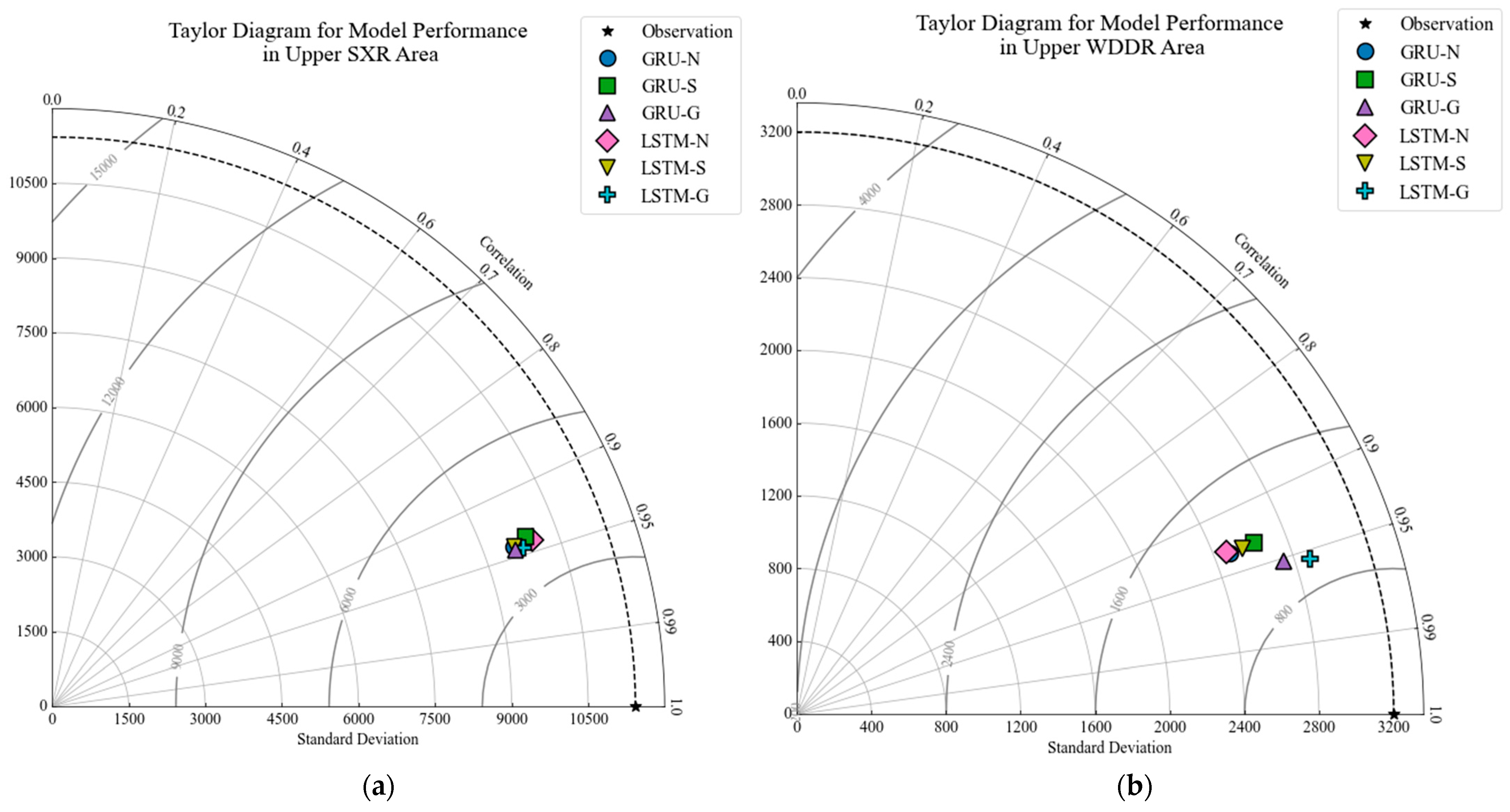
References
- Nguyen, Q.H.; Tran, V.N. Temporal Changes in Water and Sediment Discharges: Impacts of Climate Change and Human Activities in the Red River Basin (1958–2021) with Projections up to 2100. Water 2024, 16, 1155. [Google Scholar] [CrossRef]
- Jia, L.; Niu, Z.; Zhang, R.; Ma, Y. Sensitivity of Runoff to Climatic Factors and the Attribution of Runoff Variation in the Upper Shule River, North-West China. Water 2024, 16, 1272. [Google Scholar] [CrossRef]
- Xu, H.; Liu, L.; Wang, Y.; Wang, S.; Hao, Y.; Ma, J.; Jiang, T. Assessment of climate change impact and difference on the river runoff in four basins in China under 1.5 and 2.0 °C global warming. Hydrol. Earth Syst. Sci. 2019, 23, 4219–4231. [Google Scholar] [CrossRef]
- Zou, L.; Zhou, T. Near future (2016-40) summer precipitation changes over China as projected by a regional climate model (RCM) under the RCP8, 5 emissions scenario: Comparison between RCM downscaling and the driving GCM. Adv. Atmos. Sci. 2013, 30, 806–818. [Google Scholar] [CrossRef]
- Shukla, P.; Skeg, J.; Buendia, E.C.; Masson-Delmotte, V.; Pörtner, H.-O.; Roberts, D.; Zhai, P.; Slade, R.; Connors, S.; van Diemen, S. Climate Change and Land: An IPCC Special Report on Climate Change, Desertification, Land Degradation, Sustainable Land Management, Food Security, and Greenhouse Gas Fluxes in Terrestrial Ecosystems. 2019. Available online: https://www.ipcc.ch/srccl/ (accessed on 4 August 2025).
- Haj-Amor, Z.; Acharjee, T.K.; Dhaouadi, L.; Bouri, S. Impacts of climate change on irrigation water requirement of date palms under future salinity trend in coastal aquifer of Tunisian oasis. Agric. Water Manag. 2020, 228, 105843. [Google Scholar] [CrossRef]
- Piao, S.; Ciais, P.; Huang, Y.; Shen, Z.; Peng, S.; Li, J.; Zhou, L.; Liu, H.; Ma, Y.; Ding, Y. The impacts of climate change on water resources and agriculture in China. Nature 2010, 467, 43–51. [Google Scholar] [CrossRef] [PubMed]
- Larraz, B.; García-Rubio, N.; Gámez, M.; Sauvage, S.; Cakir, R.; Raimonet, M.; Pérez, J.M.S. Socio-Economic Indicators for Water Management in the South-West Europe Territory: Sectorial Water Productivity and Intensity in Employment. Water 2024, 16, 959. [Google Scholar] [CrossRef]
- Gong, G.; Wang, L.; Condon, L.; Shearman, A.; Lall, U. A simple framework for incorporating seasonal streamflow forecasts into existing water resource management practices 1. JAWRA J. Am. Water Resour. Assoc. 2010, 46, 574–585. [Google Scholar] [CrossRef]
- Sunday, R.; Masih, I.; Werner, M.; van der Zaag, P. Streamflow forecasting for operational water management in the Incomati River Basin, Southern Africa. Phys. Chem. Earth Parts A/B/C 2014, 72, 1–12. [Google Scholar] [CrossRef]
- Bărbulescu, A.; Zhen, L. Forecasting the River Water Discharge by Artificial Intelligence Methods. Water 2024, 16, 1248. [Google Scholar] [CrossRef]
- Chu, H.; Wei, J.; Wu, W. Streamflow prediction using LASSO-FCM-DBN approach based on hydro-meteorological condition classification. J. Hydrol. 2020, 580, 124253. [Google Scholar] [CrossRef]
- Feng, Z.-K.; Niu, W.-J.; Tang, Z.-Y.; Jiang, Z.-Q.; Xu, Y.; Liu, Y.; Zhang, H.-R. Monthly runoff time series prediction by variational mode decomposition and support vector machine based on quantum-behaved particle swarm optimization. J. Hydrol. 2020, 583, 124627. [Google Scholar] [CrossRef]
- Xie, S.; Xiang, Z.; Wang, Y.; Wu, B.; Shen, K.; Wang, J. An Index Used to Evaluate the Applicability of Mid-to-Long-Term Runoff Prediction in a Basin Based on Mutual Information. Water 2024, 16, 1619. [Google Scholar] [CrossRef]
- Xie, S.; Huang, Y.; Li, T.; Liu, Z.; Wang, J. Mid-long term runoff prediction based on a Lasso and SVR hybrid method. J. Basic Sci. Eng. 2018, 26, 709–722. [Google Scholar]
- Shamir, E. The value and skill of seasonal forecasts for water resources management in the Upper Santa Cruz River basin, southern Arizona. J. Arid. Environ. 2017, 137, 35–45. [Google Scholar] [CrossRef]
- Zhao, H.; Li, H.; Xuan, Y.; Bao, S.; Cidan, Y.; Liu, Y.; Li, C.; Yao, M. Investigating the critical influencing factors of snowmelt runoff and development of a mid-long term snowmelt runoff forecasting. J. Geogr. Sci. 2023, 33, 1313–1333. [Google Scholar] [CrossRef]
- Nguyen, D.H.; Elshorbagy, A.; Khaliq, M.N.; Shen, C.; Akhtar, M.K.; Moghairib, M.; Unduche, F.; Razavi, S.; Lamontagne, P. Advancing Sub-Seasonal to Seasonal Streamflow Forecasting in Canada: A Review of Conventional and Emerging Approaches for Operational Applications. Results Eng. 2025, 27, 106345. [Google Scholar] [CrossRef]
- He, C.; Chen, F.; Long, A.; Qian, Y.; Tang, H. Improving the precision of monthly runoff prediction using the combined non-stationary methods in an oasis irrigation area. Agric. Water Manag. 2023, 279, 108161. [Google Scholar] [CrossRef]
- Samsudin, R.; Saad, P.; Shabri, A. River flow time series using least squares support vector machines. Hydrol. Earth Syst. Sci. 2011, 15, 1835–1852. [Google Scholar] [CrossRef]
- Bennett, J.C.; Wang, Q.; Li, M.; Robertson, D.E.; Schepen, A. Reliable long-range ensemble streamflow forecasts: Combining calibrated climate forecasts with a conceptual runoff model and a staged error model. Water Resour. Res. 2016, 52, 8238–8259. [Google Scholar] [CrossRef]
- Crochemore, L.; Ramos, M.-H.; Pappenberger, F. Bias correcting precipitation forecasts to improve the skill of seasonal streamflow forecasts. Hydrol. Earth Syst. Sci. 2016, 20, 3601–3618. [Google Scholar] [CrossRef]
- Le, X.-H.; Ho, H.V.; Lee, G.; Jung, S. Application of long short-term memory (LSTM) neural network for flood forecasting. Water 2019, 11, 1387. [Google Scholar] [CrossRef]
- Choi, J.; Won, J.; Jang, S.; Kim, S. Learning Enhancement Method of Long Short-Term Memory Network and Its Applicability in Hydrological Time Series Prediction. Water 2022, 14, 2910. [Google Scholar] [CrossRef]
- Reichstein, M.; Camps-Valls, G.; Stevens, B.; Jung, M.; Denzler, J.; Carvalhais, N. Deep learning and process understanding for data-driven Earth system science. Nature. 2019, 566, 195–204. [Google Scholar] [CrossRef] [PubMed]
- Yaseen, Z.M.; El-Shafie, A.; Jaafar, O.; Afan, H.A.; Sayl, K.N. Artificial intelligence based models for stream-flow forecasting: 2000–2015. J. Hydrol. 2015, 530, 829–844. [Google Scholar] [CrossRef]
- Liu, Y.; Yin, Z.; Zhang, Y.; Wang, Q. Mid and long-term hydrological classification forecasting model based on KDE-BDA and its application research. IOP Conf. Ser. Earth Environ. Sci. 2019, 330, 032010. [Google Scholar] [CrossRef]
- Kratzert, F.; Klotz, D.; Shalev, G.; Klambauer, G.; Hochreiter, S.; Nearing, G. Towards learning universal, regional, and local hydrological behaviors via machine learning applied to large-sample datasets. Hydrol. Earth Syst. Sci. 2019, 23, 5089–5110. [Google Scholar] [CrossRef]
- Asefa, T.; Kemblowski, M.; Mckee, M.; Khalil, A. Multi-time scale stream flow predictions: The support vector machines approach. J. Hydrol. 2006, 318, 7–16. [Google Scholar] [CrossRef]
- Kalteh, A.M. Monthly river flow forecasting using artificial neural network and support vector regression models coupled with wavelet transform. Comput. Geosci. 2013, 54, 1–8. [Google Scholar] [CrossRef]
- Maity, R.; Bhagwat, P.P.; Bhatnagar, A. Potential of support vector regression for prediction of monthly streamflow using endogenous property. Hydrol. Process. 2010, 24, 917–923. [Google Scholar] [CrossRef]
- Noori, R.; Karbassi, A.R.; Moghaddamnia, A.; Han, D.; Zokaei-Ashtiani, M.H.; Farokhnia, A.; Gousheh, M.G. Assessment of input variables determination on the SVM model performance using PCA, Gamma test, and forward selection techniques for monthly stream flow prediction. J. Hydrol. 2011, 401, 177–189. [Google Scholar] [CrossRef]
- Lin, J.; Cheng, C.; Chau, K. Using support vector machines for long-term discharge prediction. Hydrol. Sci. J. 2006, 51, 599–612. [Google Scholar] [CrossRef]
- Tao, H.; Abba, S.I.; Al-Areeq, A.M.; Tangang, F.; Samantaray, S.; Sahoo, A.; Siqueira, H.V.; Maroufpoor, S.; Demir, V.; Dhanraj Bokde, N.; et al. Hybridized artificial intelligence models with nature-inspired algorithms for river flow modeling: A comprehensive review, assessment, and possible future research directions. Eng. Appl. Artif. Intell. 2024, 129, 107559. [Google Scholar] [CrossRef]
- Kelly, R.A.; Jakeman, A.J.; Barreteau, O.; Borsuk, M.E.; ElSawah, S.; Hamilton, S.H.; Henriksen, H.J.; Kuikka, S.; Maier, H.R.; Rizzoli, A.E. Selecting among five common modelling approaches for integrated environmental assessment and management. Environ. Model. Softw. 2013, 47, 159–181. [Google Scholar] [CrossRef]
- Mount, N.J.; Maier, H.R.; Toth, E.; Elshorbagy, A.; Solomatine, D.; Chang, F.-J.; Abrahart, R. Data-driven modelling approaches for socio-hydrology: Opportunities and challenges within the Panta Rhei Science Plan. Hydrol. Sci. J. 2016, 61, 1192–1208. [Google Scholar] [CrossRef]
- Roy, A.; Kasiviswanathan, K.; Patidar, S.; Adeloye, A.J.; Soundharajan, B.S.; Ojha, C.S.P. A novel physics-aware machine learning-based dynamic error correction model for improving streamflow forecast accuracy. Water Resour. Res. 2023, 59, e2022WR033318. [Google Scholar] [CrossRef]
- Sujay, R.N.; Deka, P.C. Support vector machine applications in the field of hydrology: A review. Appl. Soft. Comput. J. 2014, 19, 372–386. [Google Scholar]
- Liang, Z.; Li, Y.; Hu, Y.; Li, B.; Wang, J. A data-driven SVR model for long-term runoff prediction and uncertainty analysis based on the Bayesian framework. Theor. Appl. Climatol. 2018, 133, 137–149. [Google Scholar] [CrossRef]
- Wang, Q.; Zhao, T.; Yang, Q.; Robertson, D. A Seasonally Coherent Calibration (SCC) Model for Postprocessing Numerical Weather Predictions. Mon. Weather. Rev. 2019, 147, 3633–3647. [Google Scholar] [CrossRef]
- May, R.; Dandy, G.; Maier, H. Review of Input Variable Selection Methods for Artificial Neural Networks. InTech 2011, 10, 19–45. [Google Scholar]
- Mo, R.; Xu, B.; Zhong, P.-A.; Zhu, F.; Huang, X.; Liu, W.; Xu, S.; Wang, G.; Zhang, J. Dynamic long-term streamflow probabilistic forecasting model for a multisite system considering real-time forecast updating through spatio-temporal dependent error correction. J. Hydrol. 2021, 601, 126666. [Google Scholar] [CrossRef]
- Qian, X.; Wang, B.; Chen, J.; Fan, Y.; Mo, R.; Xu, C.; Liu, W.; Liu, J.; Zhong, P. An explainable ensemble deep learning model for long-term streamflow forecasting under multiple uncertainties. J. Hydrol. 2025, 662, 133968. [Google Scholar] [CrossRef]
- Mo, R.; Xu, B.; Zhong, P.-A.; Dong, Y.; Wang, H.; Yue, H.; Zhu, J.; Wang, H.; Wang, G.; Zhang, J. Long-term probabilistic streamflow forecast model with “inputs–structure–parameters” hierarchical optimization framework. J. Hydrol. 2023, 622, 129736. [Google Scholar] [CrossRef]
- Salinas, D.; Flunkert, V.; Gasthaus, J.; Januschowski, T. DeepAR: Probabilistic forecasting with autoregressive recurrent networks. Int. J. Forecast. 2020, 36, 1181–1191. [Google Scholar] [CrossRef]
- Salinas, D.; Bohlke-Schneider, M.; Callot, L.; Medico, R.; Gasthaus, J. High-Dimensional Multivariate Forecasting with Low-Rank Gaussian Copula Processes. arXiv 2019, arXiv:1910.03002. [Google Scholar]
- Schaduangrat, N.; Anuwongcharoen, N.; Charoenkwan, P.; Shoombuatong, W. DeepAR: A novel deep learning-based hybrid framework for the interpretable prediction of androgen receptor antagonists. J. Cheminform. 2023, 15, 50. [Google Scholar] [CrossRef]
- Li, J.; Chen, W.; Zhou, Z.; Yang, J.; Zeng, D. DeepAR-Attention probabilistic prediction for stock price series. Neural Comput. Appl. 2024, 36, 15389–15406. [Google Scholar] [CrossRef]
- Liao, Y.; Liang, C. A Temperature Time Series Forecasting Model Based on DeepAR. In Proceedings of the 2021 7th International Conference on Computer and Communications (ICCC), Chengdu, China, 10–13 December 2021. [Google Scholar]
- Chow, V. Applied Hydrology; McGraw-Hill: Columbus, OH, USA, 1971. [Google Scholar]
- England Jr, J.F.; Cohn, T.A.; Faber, B.A.; Stedinger, J.R.; Thomas, W.O., Jr.; Veilleux, A.G.; Kiang, J.E.; Mason, R.R., Jr. Guidelines for Determining Flood Flow Frequency—Bulletin 17C; US Geological Survey: Reston, VA, USA, 2018.
- Wu, W.; Dandy, G.C.; Maier, H.R. Protocol for developing ANN models and its application to the assessment of the quality of the ANN model development process in drinking water quality modelling. Environ. Model. Softw. 2014, 54, 108–127. [Google Scholar] [CrossRef]
- Xie, S.; Wu, W.; Mooser, S.; Wang, Q.; Nathan, R.; Huang, Y. Artificial neural network based hybrid modeling approach for flood inundation modeling. J. Hydrol. 2021, 592, 125605. [Google Scholar] [CrossRef]
- Maier, H.R.; Jain, A.; Dandy, G.C.; Sudheer, K.P. Methods used for the development of neural networks for the prediction of water resource variables in river systems: Current status and future directions. Environ. Model. Softw. 2010, 25, 891–909. [Google Scholar] [CrossRef]
- Demir, V. Evaluation of Solar Radiation Prediction Models Using AI: A Performance Comparison in the High-Potential Region of Konya, Türkiye. Atmosphere 2025, 16, 398. [Google Scholar] [CrossRef]
- Kingma, D.; Adam, J.B. A Method for Stochastic Optimization. Comput. Sci. 2014, 5, 6. [Google Scholar]
- De Faria, V.; De Queiroz, A.; Lima, L.; Lima, J.; Da Silva, B. An assessment of multi-layer perceptron networks for streamflow forecasting in large-scale interconnected hydrosystems. Int. J. Environ. Sci. Technol. 2022, 19, 5819–5838. [Google Scholar] [CrossRef]
- Humphrey, G.B.; Maier, H.R.; Wu, W.; Mount, N.J.; Dandy, G.C.; Abrahart, R.J.; Dawson, C.W. Improved validation framework and R-package for artificial neural network models. Environ. Model. Softw. 2017, 92, 82–106. [Google Scholar] [CrossRef]
- Gneiting, T.; Raftery, A.E.; Westveld, A.H., III; Goldman, T. Calibrated probabilistic forecasting using ensemble model output statistics and minimum CRPS estimation. Mon. Weather. Rev. 2005, 133, 1098–1118. [Google Scholar] [CrossRef]
- Renard, B.; Kavetski, D.; Kuczera, G.; Thyer, M.; Franks, S.W. Understanding predictive uncertainty in hydrologic modeling: The challenge of identifying input and structural errors. Water Resour. Res. 2010, 46, W05521. [Google Scholar] [CrossRef]
- See, L.; Abrahartand, R.J. Multi-model data fusion for hydrological forecasting. Comput. GeoSci. 2001, 27, 987–994. [Google Scholar] [CrossRef]
- Azmi, M.; Araghinejad, S.; Kholghi, M. Multi model data fusion for hydrological forecasting using k-nearest neighbour method. Iran. J. Sci. Technol. 2010, 34, 81. [Google Scholar]
- Wang, Q.; Schepen, A.; Robertson, D.E. Merging seasonal rainfall forecasts from multiple statistical models through Bayesian model averaging. J. Clim. 2012, 25, 5524–5537. [Google Scholar] [CrossRef]
- Schepen, A.; Wang, Q.; Everingham, Y. Calibration, bridging, and merging to improve GCM seasonal temperature forecasts in Australia. Mon. Weather. Rev. 2016, 144, 2421–2441. [Google Scholar] [CrossRef]
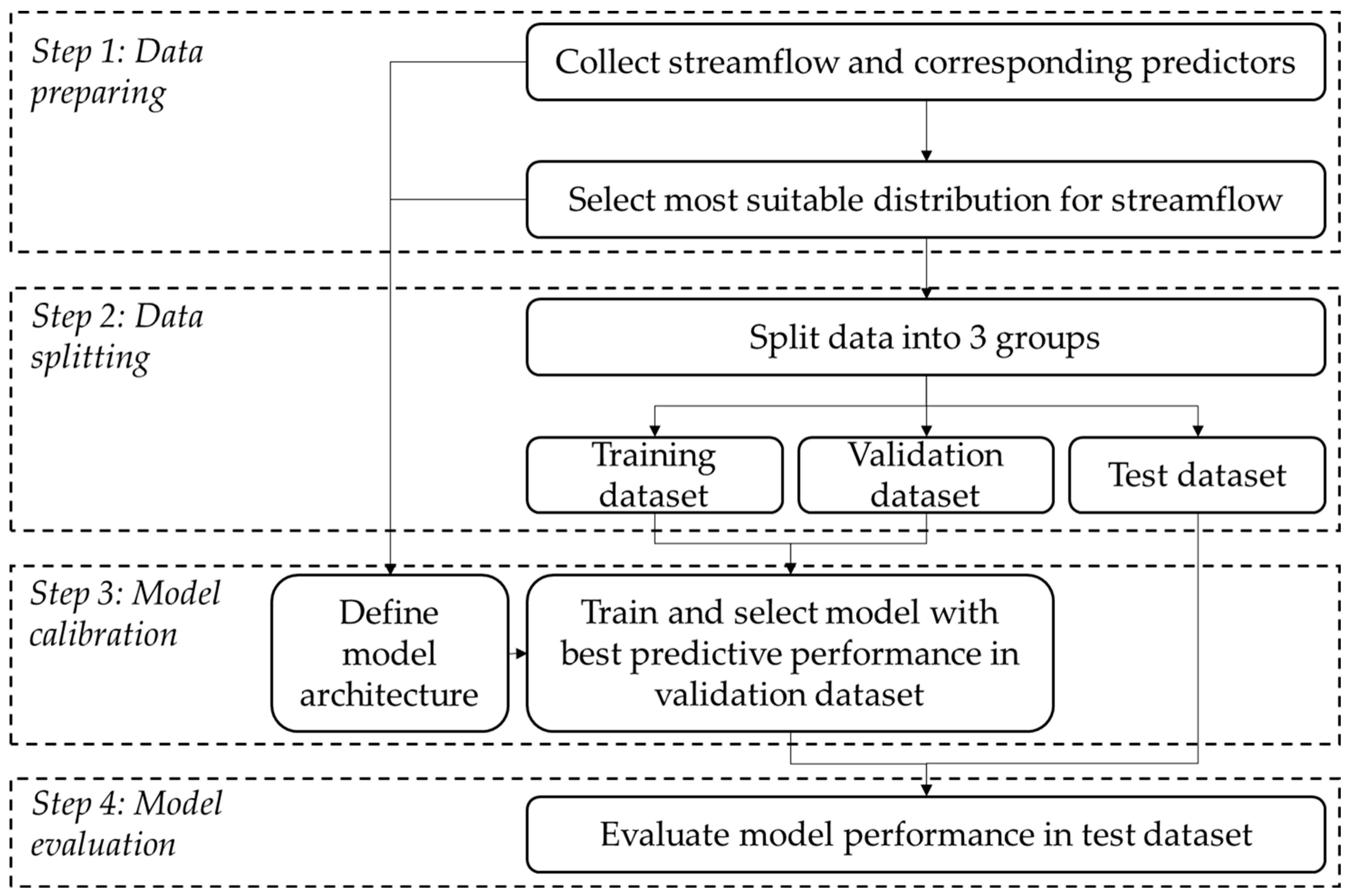
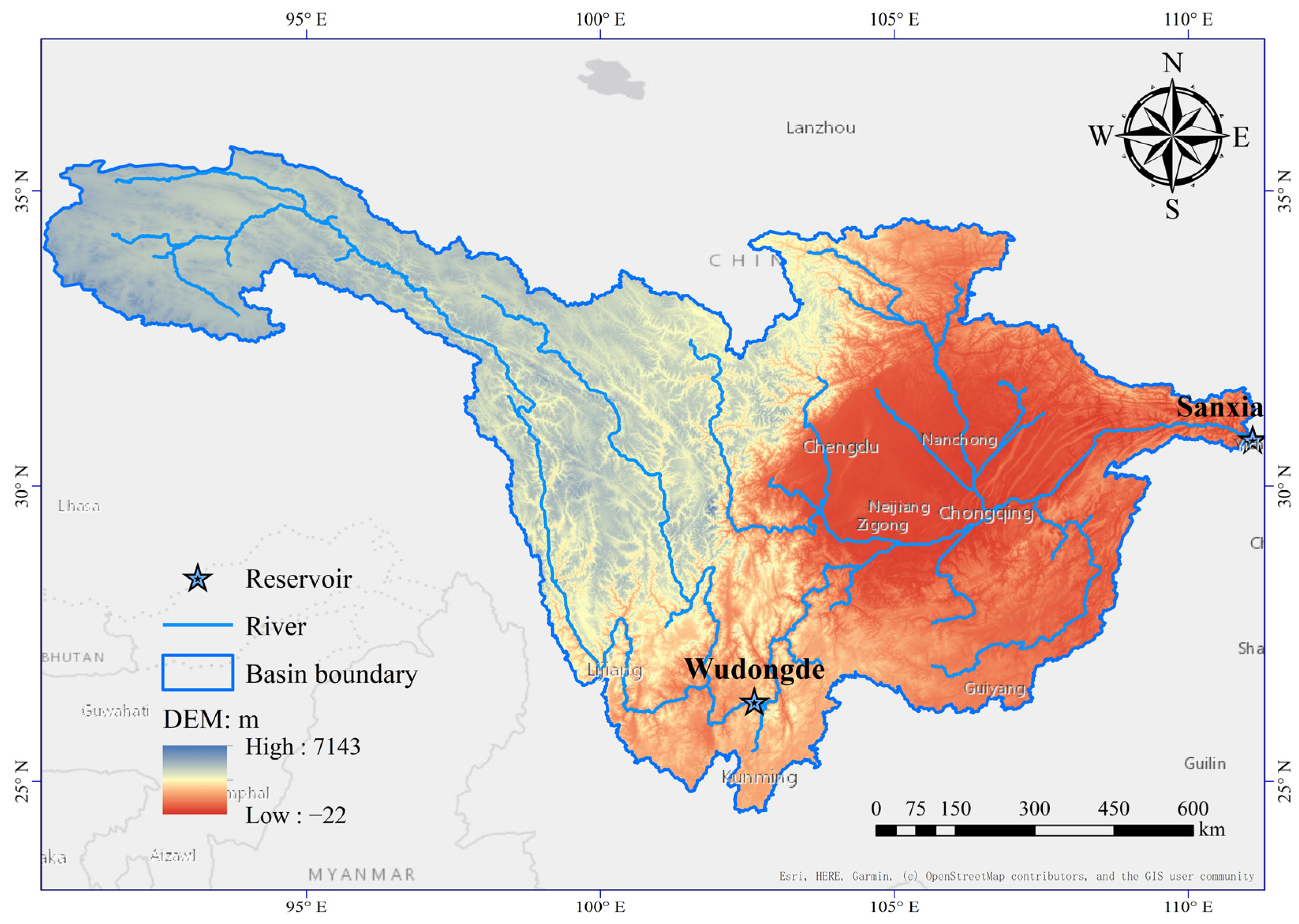
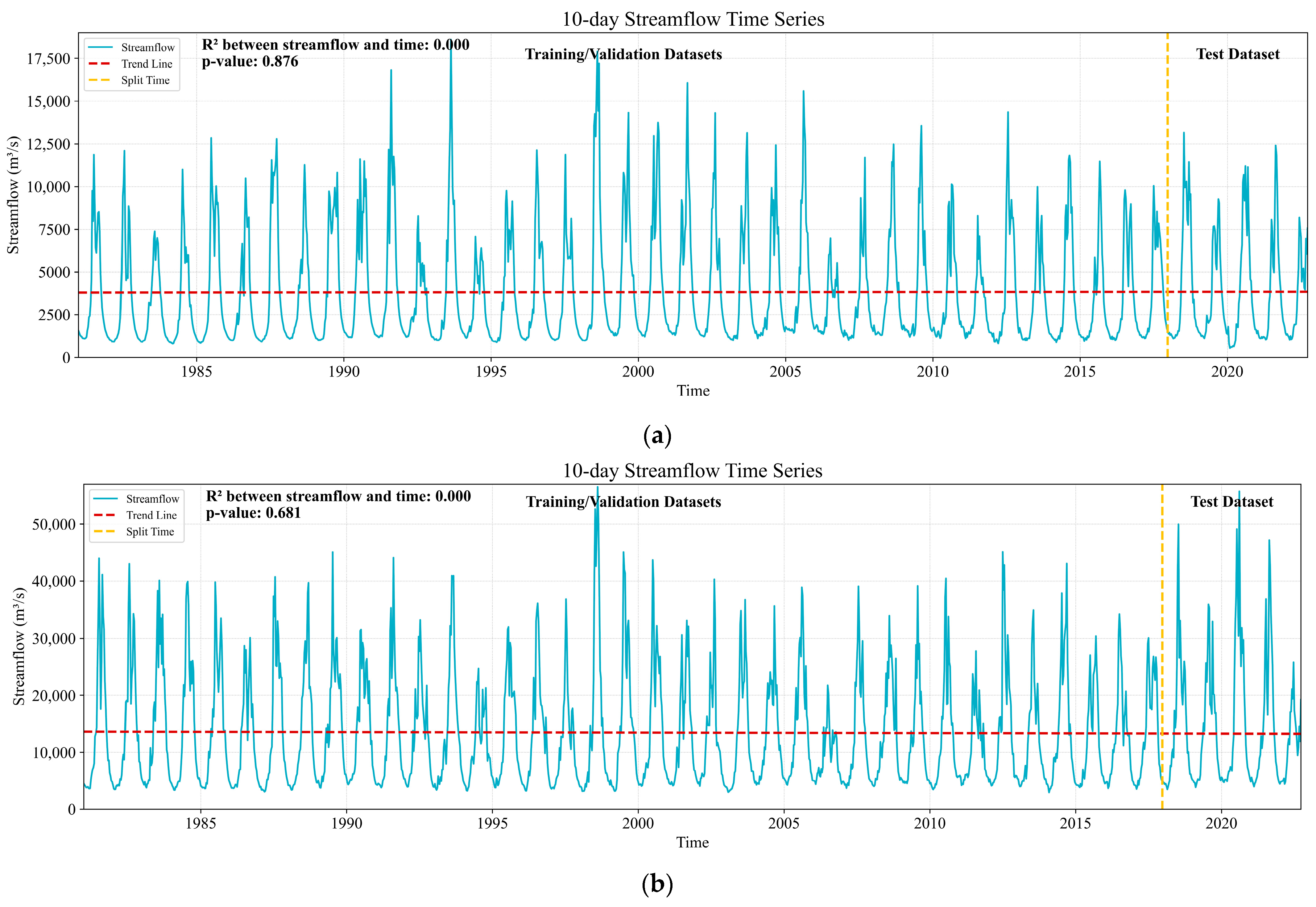
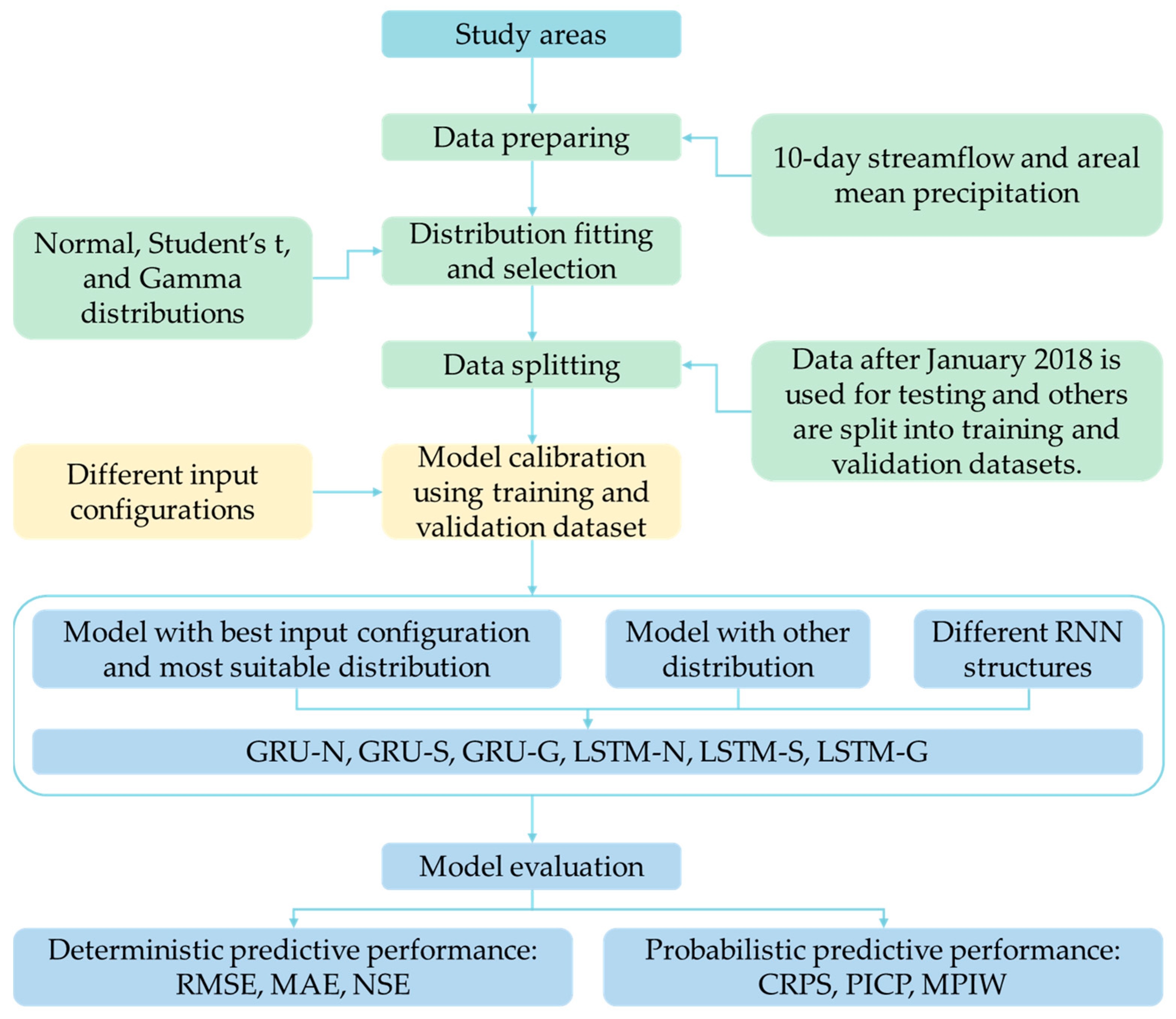

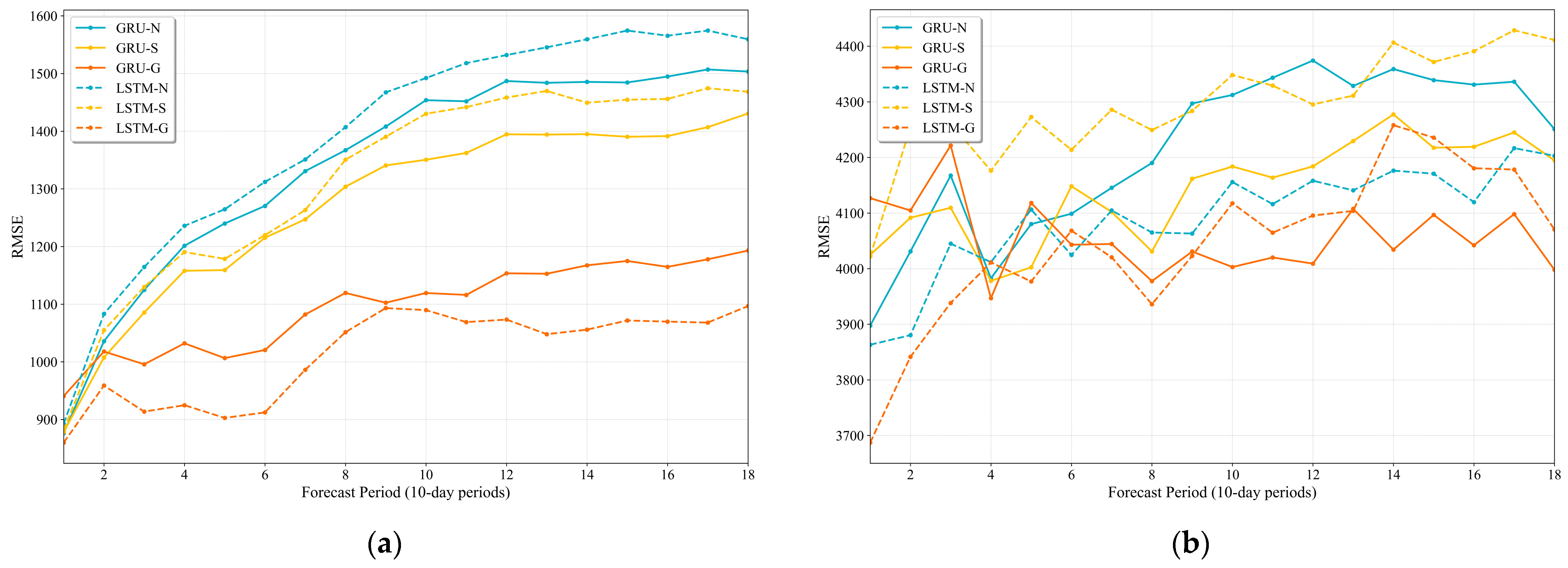
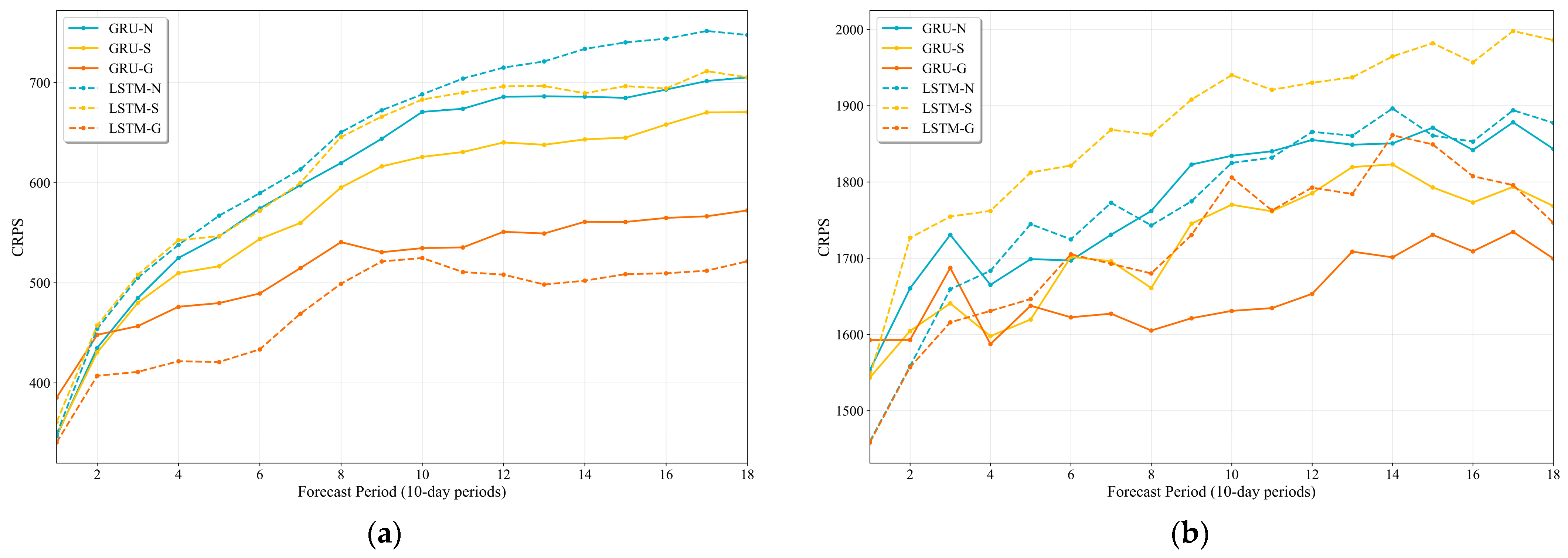
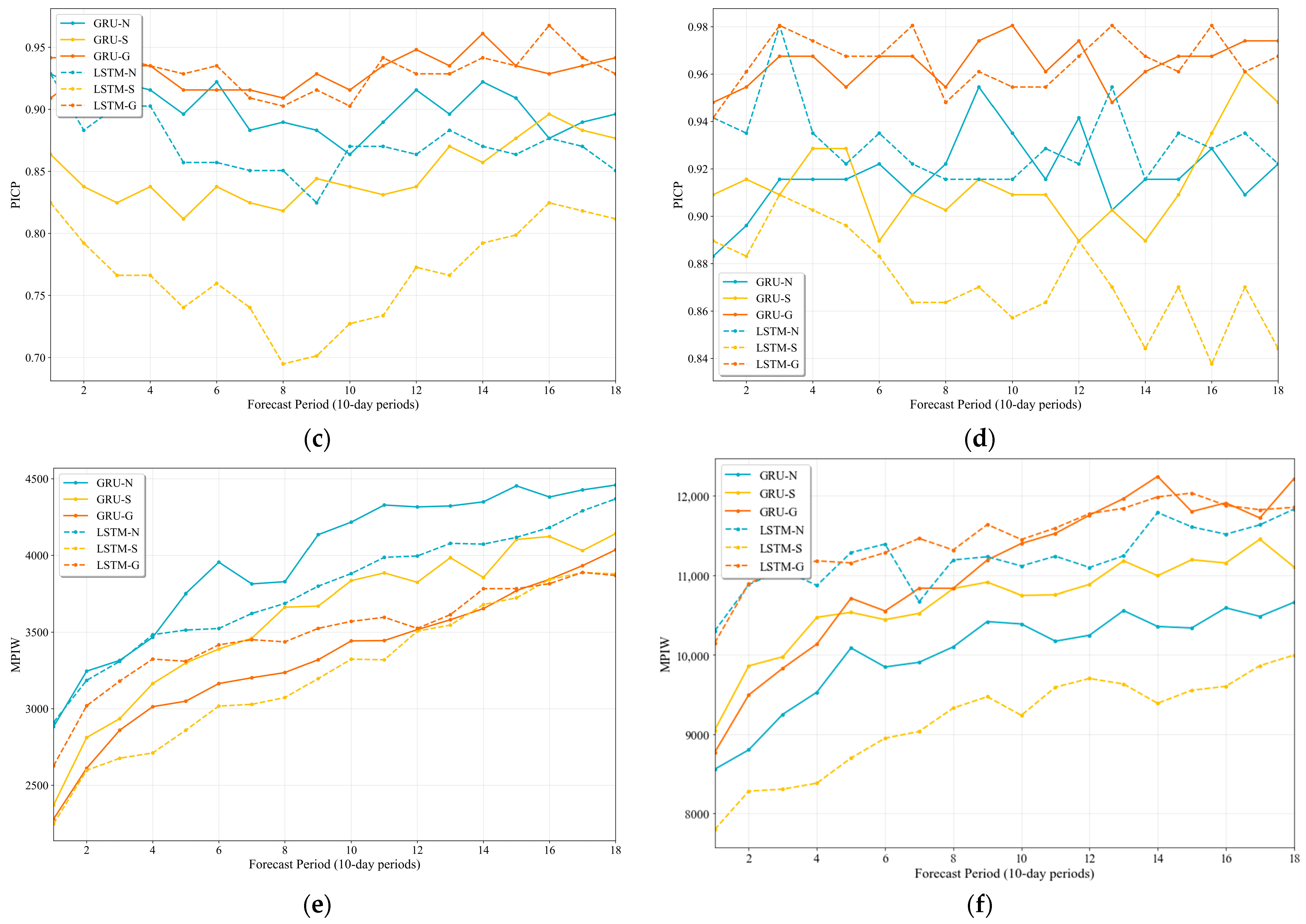
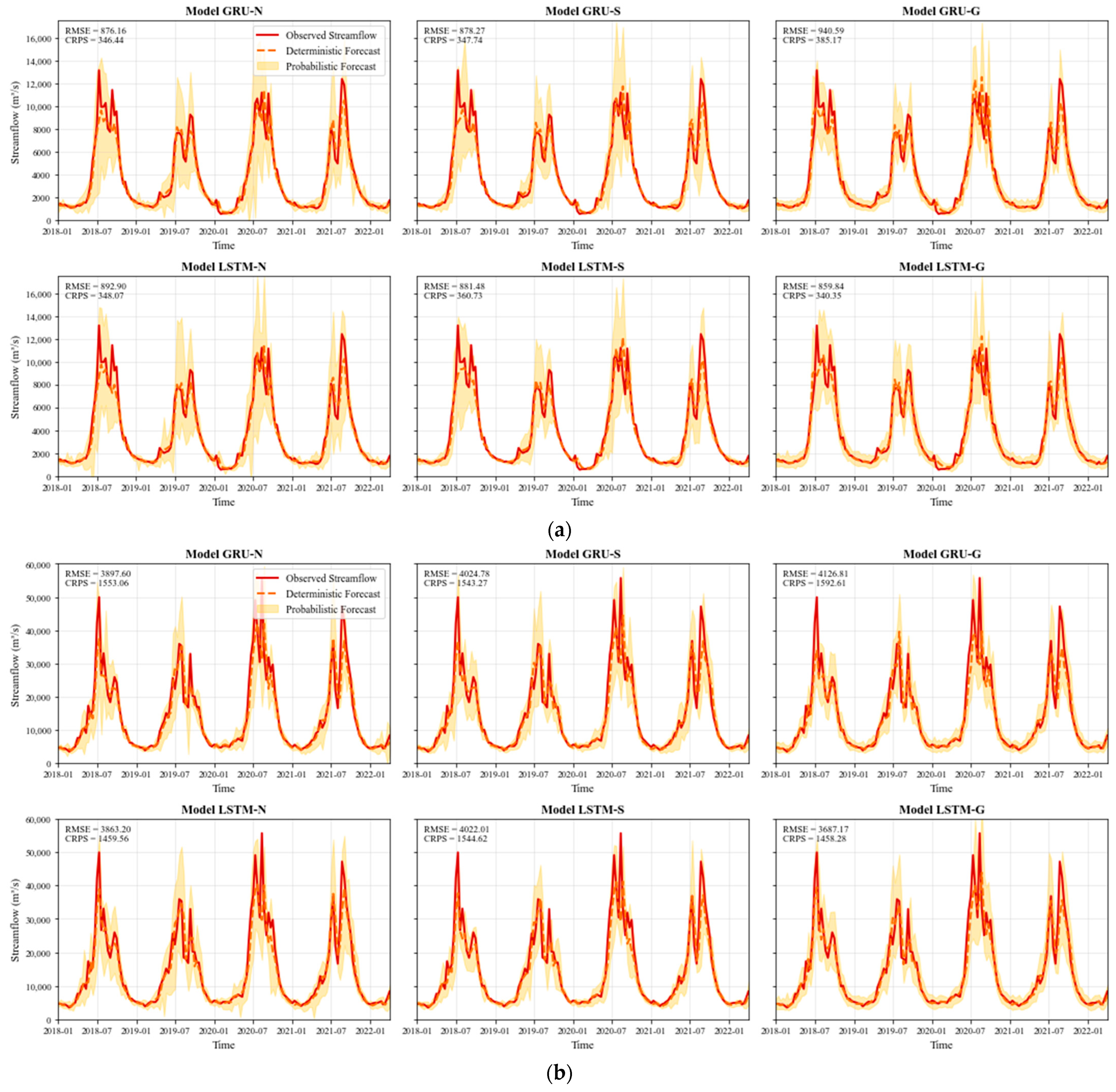
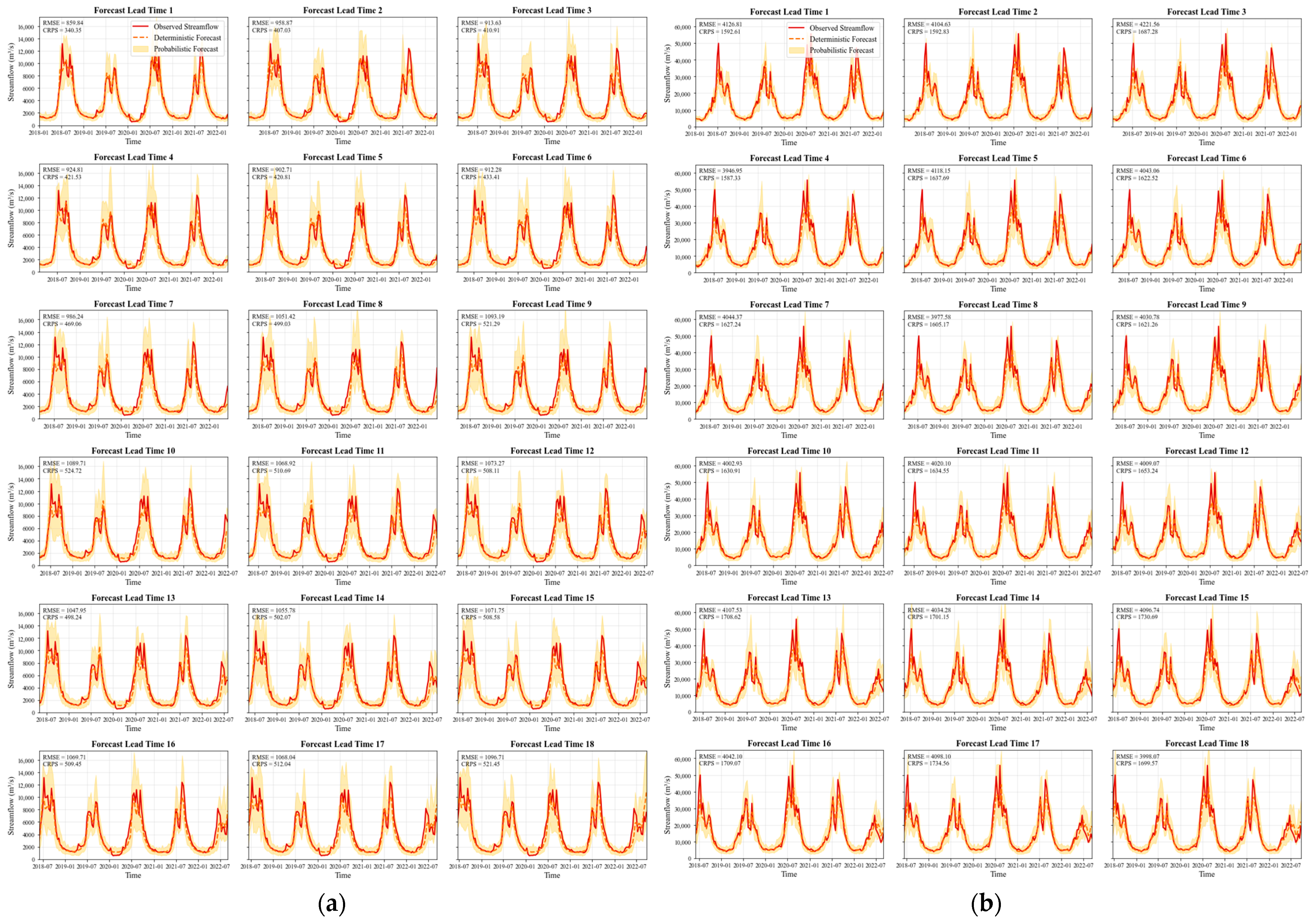
| Study Area | Upper WDDR Area | Upper SXR Area | ||
|---|---|---|---|---|
| Variable | Naturalized Streamflow | Areal Mean Precipitation | Naturalized Streamflow | Areal Mean Precipitation |
| Temporal coverage and scale | January 1980 to September 2022 10-day time scale | |||
| Min | 557 m3/s | 0.00 mm | 2910 m3/s | 0.10 mm |
| Max | 18,600 m3/s | 90.83 mm | 56,500 m3/s | 91.41 mm |
| Average | 3819.97 m3/s | 17.59 mm | 13,432.22 m3/s | 22.69 mm |
| Standard deviation | 3247.06 m3/s | 18.98 mm | 10,016.31 m3/s | 20.36 mm |
| Coefficient of variation | 0.85 | 1.07 | 0.75 | 0.84 |
| Skewness | 1.35 | 0.22 | 1.21 | −0.26 |
| Kurtosis | 1.23 | 1.08 | 0.98 | 0.89 |
| Study Area | Distribution | AIC | BIC |
|---|---|---|---|
| Upper WDDR area | Normal | 25,335.35 | 25,345.73 |
| Student’s t | 25,223.80 | 25,239.38 | |
| Gamma | 24,044.36 | 24,059.95 | |
| Upper SXR area | Normal | 28,283.95 | 28,294.34 |
| Student’s t | 28,285.95 | 28,301.54 | |
| Gamma | 27,308.55 | 27,324.14 |
| Input Configuration | Average RMSE on Validation Dataset of Different Models for Upper WDDR Area (m3/s) | Average RMSE on Validation Dataset of Different Models for Upper SXR Area (m3/s) | |
|---|---|---|---|
| Lags of precipitation | 0 | 1277.07 | 3634.55 |
| 0, 1 | 1237.00 | 3616.81 | |
| 0, 1, 2 | 1199.21 | 3481.18 | |
| Lags of streamflow | 1 | 1245.33 | 3577.72 |
| 1, 2 | 1230.19 | 3577.31 | |
| Study Area | Evaluation Metrics | Model | |||||
|---|---|---|---|---|---|---|---|
| GRU-N | GRU-S | GRU-G | LSTM-N | LSTM-S | LSTM-G | ||
| Upper WDDR area | RMSE (m3/s) | 1356.74 | 1282.09 | 1098.98 | 1407.77 | 1331.08 | 1016.54 |
| MAE (m3/s) | 817.92 | 775.23 | 699.40 | 844.78 | 816.79 | 643.99 | |
| NSE | 0.82 | 0.84 | 0.88 | 0.81 | 0.83 | 0.89 | |
| CRPS (m3/s) | 608.89 | 578.95 | 517.54 | 637.95 | 620.08 | 473.26 | |
| PICP (%) | 90.08 | 84.81 | 92.93 | 87.09 | 76.84 | 93.15 | |
| MPIW (m3/s) | 3980.52 | 3585.95 | 3330.88 | 3778.34 | 3228.71 | 3485.17 | |
| Upper SXR area | RMSE (m3/s) | 4217.12 | 4143.33 | 4057.33 | 4091.22 | 4296.16 | 4047.15 |
| MAE (m3/s) | 2346.57 | 2289.88 | 2222.94 | 2370.06 | 2487.38 | 2312.61 | |
| NSE | 0.86 | 0.87 | 0.87 | 0.87 | 0.86 | 0.87 | |
| CRPS (m3/s) | 1776.92 | 1716.52 | 1654.24 | 1771.43 | 1870.94 | 1717.93 | |
| PICP (%) | 91.77 | 91.45 | 96.46 | 93.11 | 87.27 | 96.54 | |
| MPIW (m3/s) | 10,015.73 | 10,669.20 | 11,048.15 | 11,218.44 | 9156.87 | 11,464.91 | |
| Forecast Horizon (10-Day Periods) | Upper WDDR Area | Upper SXR Area | ||||||||||
|---|---|---|---|---|---|---|---|---|---|---|---|---|
| GRU-N | GRU-S | GRU-G | LSTM-N | LSTM-S | LSTM-G | GRU-N | GRU-S | GRU-G | LSTM-N | LSTM-S | LSTM-G | |
| 1 | 876.2 | 878.3 | 940.6 | 892.9 | 881.5 | 859.8 | 3897.6 | 4024.8 | 4126.8 | 3863.2 | 4022.0 | 3687.2 |
| 2 | 1035.7 | 1007.6 | 1017.9 | 1083.1 | 1054.9 | 958.9 | 4031.0 | 4091.6 | 4104.6 | 3880.4 | 4254.2 | 3841.5 |
| 3 | 1124.9 | 1085.5 | 995.7 | 1164.5 | 1129.9 | 913.6 | 4167.4 | 4109.5 | 4221.6 | 4045.0 | 4260.8 | 3938.4 |
| 4 | 1201.3 | 1157.9 | 1032.1 | 1235.9 | 1190.4 | 924.8 | 3982.7 | 3978.0 | 3947.0 | 4011.7 | 4176.2 | 4011.2 |
| 5 | 1239.9 | 1159.2 | 1006.4 | 1264.5 | 1178.6 | 902.7 | 4080.1 | 4002.4 | 4118.1 | 4106.4 | 4272.7 | 3977.0 |
| 6 | 1270.4 | 1215.3 | 1020.5 | 1312.1 | 1219.7 | 912.3 | 4098.8 | 4148.2 | 4043.1 | 4024.7 | 4213.8 | 4068.3 |
| 7 | 1330.8 | 1247.1 | 1082.2 | 1351.1 | 1263.2 | 986.2 | 4145.4 | 4102.0 | 4044.4 | 4104.7 | 4285.8 | 4020.6 |
| 8 | 1367.0 | 1303.7 | 1119.5 | 1406.9 | 1350.6 | 1051.4 | 4190.1 | 4031.1 | 3977.6 | 4065.0 | 4249.4 | 3936.1 |
| 9 | 1408.0 | 1340.6 | 1102.5 | 1467.4 | 1390.4 | 1093.2 | 4297.1 | 4161.7 | 4030.8 | 4063.2 | 4283.7 | 4023.0 |
| 10 | 1453.8 | 1350.4 | 1119.3 | 1492.2 | 1430.3 | 1089.7 | 4312.4 | 4183.7 | 4002.9 | 4155.7 | 4348.2 | 4117.6 |
| 11 | 1451.8 | 1362.3 | 1116.0 | 1518.1 | 1441.8 | 1068.9 | 4343.3 | 4163.7 | 4020.1 | 4116.1 | 4329.2 | 4064.6 |
| 12 | 1487.0 | 1394.6 | 1153.5 | 1532.0 | 1458.4 | 1073.3 | 4374.3 | 4184.0 | 4009.1 | 4158.2 | 4295.4 | 4095.5 |
| 13 | 1483.9 | 1394.1 | 1152.8 | 1545.5 | 1469.7 | 1048.0 | 4328.6 | 4229.5 | 4107.5 | 4140.8 | 4311.1 | 4103.9 |
| 14 | 1485.5 | 1394.9 | 1167.4 | 1559.4 | 1449.5 | 1055.8 | 4358.9 | 4277.4 | 4034.3 | 4176.3 | 4406.5 | 4258.0 |
| 15 | 1484.5 | 1390.3 | 1174.9 | 1574.5 | 1454.6 | 1071.8 | 4339.0 | 4217.5 | 4096.7 | 4170.8 | 4371.7 | 4235.7 |
| 16 | 1494.8 | 1391.5 | 1164.6 | 1565.6 | 1456.0 | 1069.7 | 4331.0 | 4219.1 | 4042.1 | 4119.7 | 4391.1 | 4180.6 |
| 17 | 1507.1 | 1407.0 | 1177.8 | 1574.5 | 1474.5 | 1068.0 | 4336.2 | 4245.0 | 4098.1 | 4216.8 | 4428.7 | 4178.2 |
| 18 | 1503.5 | 1430.7 | 1192.9 | 1559.5 | 1468.4 | 1096.7 | 4251.0 | 4194.8 | 3998.1 | 4203.0 | 4411.2 | 4070.5 |
Disclaimer/Publisher’s Note: The statements, opinions and data contained in all publications are solely those of the individual author(s) and contributor(s) and not of MDPI and/or the editor(s). MDPI and/or the editor(s) disclaim responsibility for any injury to people or property resulting from any ideas, methods, instructions or products referred to in the content. |
© 2025 by the authors. Licensee MDPI, Basel, Switzerland. This article is an open access article distributed under the terms and conditions of the Creative Commons Attribution (CC BY) license (https://creativecommons.org/licenses/by/4.0/).
Share and Cite
Xie, S.; Wang, D.; Wang, J.; Yang, C.; Shen, K.; Jia, B.; Cao, H. A DeepAR-Based Modeling Framework for Probabilistic Mid–Long-Term Streamflow Prediction. Water 2025, 17, 2506. https://doi.org/10.3390/w17172506
Xie S, Wang D, Wang J, Yang C, Shen K, Jia B, Cao H. A DeepAR-Based Modeling Framework for Probabilistic Mid–Long-Term Streamflow Prediction. Water. 2025; 17(17):2506. https://doi.org/10.3390/w17172506
Chicago/Turabian StyleXie, Shuai, Dong Wang, Jin Wang, Chunhua Yang, Keyan Shen, Benjun Jia, and Hui Cao. 2025. "A DeepAR-Based Modeling Framework for Probabilistic Mid–Long-Term Streamflow Prediction" Water 17, no. 17: 2506. https://doi.org/10.3390/w17172506
APA StyleXie, S., Wang, D., Wang, J., Yang, C., Shen, K., Jia, B., & Cao, H. (2025). A DeepAR-Based Modeling Framework for Probabilistic Mid–Long-Term Streamflow Prediction. Water, 17(17), 2506. https://doi.org/10.3390/w17172506







